
The LONDON TRANSPORT Leyland Cubs
This page created 23rd May 1998, updated 7th November 2019, using Wordpad, by Ian Smith.
Contents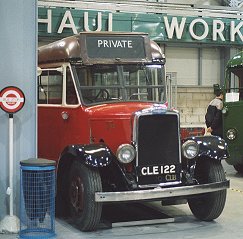
Many thanks to Peter Osborn for information about the Central Area Cubs during the war and afterwards.
IntroductionWhen London Transport was formed in 1933 it inherited a wide variety of small buses. By "small" I mean 20 seats or fewer. There were the General's 42 Chiswick-bodied Darts (DA); some Morris Viceroys (MS); some small Bedfords (BD); some small Gilfords; a few Beans (of different sizes) (BN); Commer Invaders; Thorneycroft Nippys (NY); some small Guys; two Dennis Aces and a Dennis Mace (DC); and a single Leyland Cub (C), plus a host of tiny buses including Dennis GLs (DS), (DM); Morris Commercials and Chevrolets. Some were more satisfactory than others, and London Transport gave consideration to buying more Cubs, more Thorneycrofts and more Dennis Darts. The problem was quite urgent: LT downseated some ex-Green Line Gilfords to 20-seater buses as an interim measure, and purchased another Cub chassis, to be fitted with a Chiswick body and trialled: C1. This, together with the Cub from St Albans and District (C76), seems to have made a really good impression, as the other types under consideration gave way to the Cub, another 74 being ordered for the Country Area in 1935 (C2-C75), and 22 for the Central Area in 1936.A new venture for London was the provision of a specialised bus service to connect the London railway termini at night, which required buses with a large luggage capacity. For this LT bought a small fleet of semi-decker Cubs, with a luggage locker below a raised rear seating area, - the 8 Interstation Cubs.
Chassis: Leyland Cub, 15ft 6in wheel-base;
It may seem strange that this first of LT's Cubs should be C76,
but on acquisition along with St Albans and District (in November 1933)
it was allocated to Country services,
which did not adopt the Chiswick numbering scheme immediately.
It received its number in 1935,
after the purchase of the Country Area's main batch of Cubs.
Outsider it may have been,
but for once the planners in LT seem not to have followed the LGOC ideas
and recognized a good bus when they operated it!
C76 did not stay at St Albans.
After a repaint into green and black it went for service to Northfleet.
It moved on to Langley Road in Slough, to be used on the Slough - Windsor services,
finally being withdrawn from Windsor (WR) in October 1938.
It was always something of an oddity, with its non-standard body and petrol engine.
After withdrawal it yielded its petrol engine to C1,
receiving the Perkins Leopard in exchange,
before sale in January 1939.
The Chiswick Cub: C1, AYV 717, 1C1, (Total 1)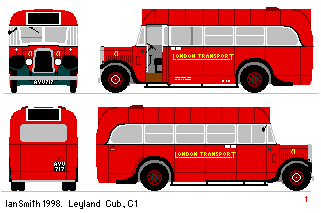 Introduced: June 1934.
Introduced: June 1934.
Chassis: Leyland Cub, 15ft 6in wheel-base,
Body: B20F, Chiswick, 24ft 0in long.
Chassis: Leyland Cub KPO3, 15ft 6in wheel-base,
Body: B20F, Short Bros, 24ft 0in long.
The first 7 (C2-C8), went to Northfleet (NF) for the North Kent rural services, in mid-April 1935,
followed by an allocation to Dunton Green (DG) for the Sevenoaks, Knockholt and Orpington routes.
Hertford (HG) and St Albans (SA) were next in line, for the northern collection of small-bus routes.
Chelsham (CM), Guildford (GF) and Leatherhead (LH) had a large number for the Surrey Hills and North Downs services,
and Addlestone (WY) and Windsor (WR) for the interface with Aldershot and District.
Watford (WA) and Amersham (MA) were other northern users, and Dorking (DS) had some for use in the Weald.
All were in use by September 1935.
Livery when new was two shades of green with black lining and mudguards,
but the light green presently gave way to white.
The area of white around the windows varied from bus to bus.
During the war years the mudgard tips and rear were marked in white to
help during the blackout.
Many Country routes were double-decked to cope with wartime demand, using Central Area buses,
and some of the Country Cubs were loaned to the Central Area in return.
Three went on loan as part of the "We're all in this together" campaign: C16, C52 and C69.
After the war 21 of them were sold for use in Belgium by the Allied Economic Commission.
The others were joined on Country duties by the remainder of the Central Cubs (see below),
so that 66 were still in Country service in 1950. In 1948-50 a number of lightly trafficked routes were introduced, once the desperate shortages of bus had been lessened by the advent of postwar Ts and RTs.
These were spread all round the London Transport area, or even just beyond, in the case of the 383 (which caused a protest by the local operator).
They continued in use during the early 50's, and LT considered rebodying them.
They eventually had direct replacements in the shape of the 84 members of the
GS class.
That the GS was so similar in form was a compliment to the way that the Cubs
had carried out their duties for some eighteen years.
Many were then sold for non-PSV use in the Home Counties,
whilst a large number went to Ceylon.
C4 became a fruit-farm vehicle, before rescue for preservation. Eventually Ensignbus bought it for their Museum,
and after a five year restoration have returned it to excellent running order.
Chassis: Leyland Cub KPO3, 15ft 6in wheel-base,
Body: B20F, Weymann, 24ft 0in long.
The Cubs for the Central Area had the larger, 4.7 litre engine,
and were bodied by Weymann to a design virtually indistinguishable
from the Short Bros bodies on the Country Cubs.
They did however have route stencil holders above the doorway and on the offside,
in line with Central practice.
(In the Country Area buses changed frequently between routes on a day's duties,
so route stencils were NOT used).
Another obvious change was the lack of a front bumper bar.
These had come into vogue during 1934-35, appearing on the early Cubs and
on the 9T9s and LTCs, but just as suddenly had gone back out of fashion.
The Central Cubs were to replace the small buses already operating around
the Central Area, apart from the Darts. (The Darts still had duties to perform
during the week, and more on Saturdays, so they were retained for the time being).
All the Cubs went into service in April and May 1936, at Mortlake (M),
Hanwell (HW), Enfield (E), Barking (BK) and Harrow Weald (HD).
In the north-east and north-west areas the Cubs and Darts were on rural
routes similar to those in the Country Area,
whilst there were still a few developmental routes in other parts where
small buses could be used to build the business.
But the pace of development was such that small buses were being squeezed
out by lack of capacity (a problem faced afresh during the 1980's minibus "revolution").
Twenty seaters, even one-man operated, could not compete with 56 seaters where business was buoyant.
Things came to a head during the war, when bus capacity had to increase dramatically to cope.
The Dennis Dart Central Area routes (* below) had themselves been upsized to Cub operation
at the start of the war,
leaving the following routes with Cubs (except the 207, which was withdrawn):
Two new Central Area Cub routes were introduced during the war: the 238
(Emerson Park to Noak Hill) in 1940 and the 225 (Northwood Hills to Eastcote)
in 1944. The latter was short-lived as an one man operation,
as heavy traffic soon caused its conversion to larger crewed buses.
At the end of the war nine had been sold for service with the Allied Economic Mission for use in Belgium,
whilst others were sold for other uses. Some remained in use in the Country Area until 1953-4.
C94 was rescued from a farm, still wearing its 480 blinds, and is in preservation.
Its future was further secured when it was acquired by the London Transport Museum.
Cubs preserved: C94 seen in company with C111. Photo, used with permission, by Mike Dawes. Click for larger picture.
Chassis: Leyland Cub SKPZ2, 15ft 6in wheel-base,
Body:Park Royal, 24ft 0in long.
The remaining eight Cub buses were some of London's oddest.
They were required for the takeover of the night-time service between the
major London Railway termini, that was operated until October 1936 by P.Hearn.
The traffic was not large, but select, with significant luggage
- rather like early airline traffic.
The solution was like that adopted by LT for BEA after the war:
a semi-decker coach, with a large luggage hold at the rear, with seating above.
I am told that they seated twenty, but having built a model can only account for nineteen:
eight downstairs and eleven above.
The first, C106, was delivered in April 1936, and was thoroughly road-tested between
Chiswick and Park Royal until September, when it was licensed.
The others, delivered to Old Kent Road (P) in May, were licensed for operations in October.
BEA hired them for a while in 1951 for airport traffic: a foretaste of the
BEA RFs to come, but a different generation.
C107 was sold to London Fire Brigade for use as a control unit,
while C111 was used by them as a personnel vehicle until 1961.
C111 is preserved in excellent condition, and has occasionally been seen at rallies.
PostscriptThe 1938 bus orders nearly resulted in another 74 Cubs. But someone realised that the numbers of remaining Darts (42) and Bedfords (12) already totalled less than this. The small bus business was dwindling anyway. Eventually the order was reduced, to 49, and emerged during 1938 and 1939 in the much revised form of the CR class, the rear-engined Cubs. But they are another story!There WERE London Transport Cubs numbered C99L-C105L, and also C114L. But these were lorries in the service fleet, not buses.
|
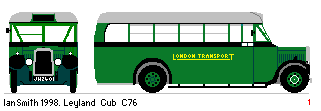 Introduced: 1932 (Stn Albans and District)
Introduced: 1932 (Stn Albans and District)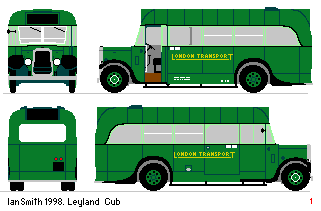 Introduced: 17th April 1935.
Introduced: 17th April 1935.
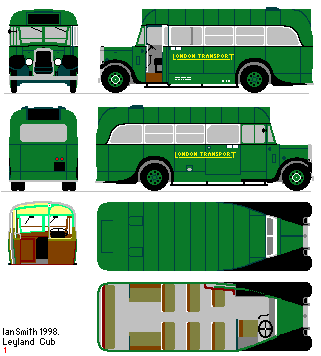 The bodies had small differences from C1, the largest being the placing of the
emergency door behind the driver instead of at the rear offside, plus
changes in the interior trimming that became the norm for LT.
As Chiswick was fully occupied with other building programmes
(with a maximum annual build laid down by law) the bodies were built by
Short Brothers at Rochester. This was LTs only contract with them,
but LT was familiar with their bus work in some of the STs inherited from some
of the Country Area's previous companies.
They were better-known for their manufacture of aircraft, in particular flying boats,
and the increased preparations as the thirties progressed meant that they
were unable to tackle the repeat order.
The bodies had small differences from C1, the largest being the placing of the
emergency door behind the driver instead of at the rear offside, plus
changes in the interior trimming that became the norm for LT.
As Chiswick was fully occupied with other building programmes
(with a maximum annual build laid down by law) the bodies were built by
Short Brothers at Rochester. This was LTs only contract with them,
but LT was familiar with their bus work in some of the STs inherited from some
of the Country Area's previous companies.
They were better-known for their manufacture of aircraft, in particular flying boats,
and the increased preparations as the thirties progressed meant that they
were unable to tackle the repeat order.
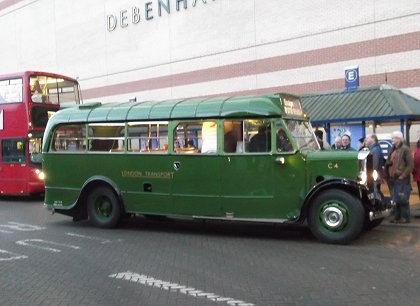
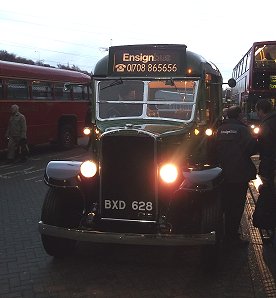
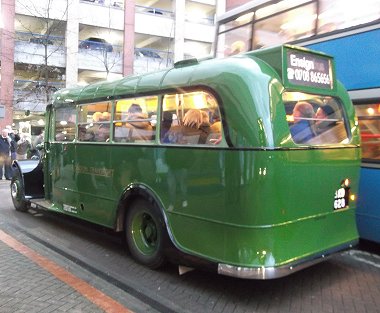
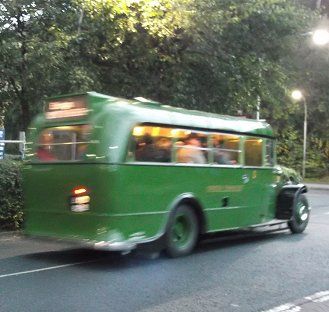
 Individual bus histories.
Individual bus histories.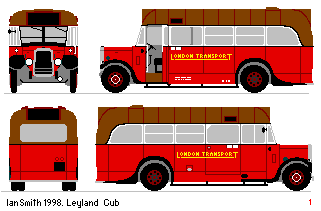 Introduced: April 1936.
Introduced: April 1936.
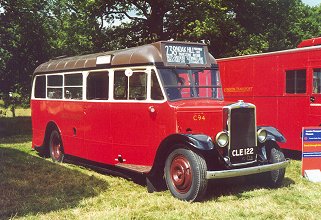
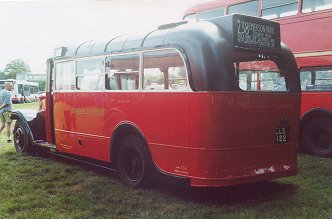
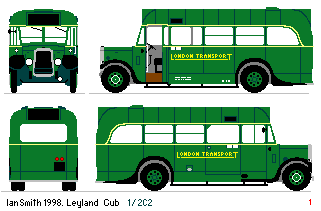 By 1945 there were still three Cub routes: the 206, which now ran from Imber Court to Claygate (Kingston),
and the 238 and 252 from Hornchurch. The 206 acquired 14T12s in September 1946,
when it was extended to operate to Hampton Court from Claygate.
The Hornchurch eight (or nine) persisted on the 238 and 252 until 19th July 1949,
when they too were replaced by crew-operated Ts, and went to the Country Area in Surrey.
These were repainted into green, some into the new Country Area livery of green with cream piping.
By 1945 there were still three Cub routes: the 206, which now ran from Imber Court to Claygate (Kingston),
and the 238 and 252 from Hornchurch. The 206 acquired 14T12s in September 1946,
when it was extended to operate to Hampton Court from Claygate.
The Hornchurch eight (or nine) persisted on the 238 and 252 until 19th July 1949,
when they too were replaced by crew-operated Ts, and went to the Country Area in Surrey.
These were repainted into green, some into the new Country Area livery of green with cream piping.
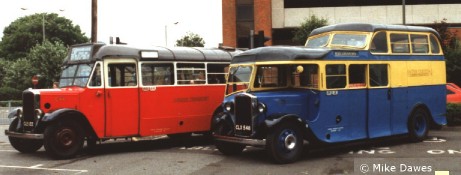
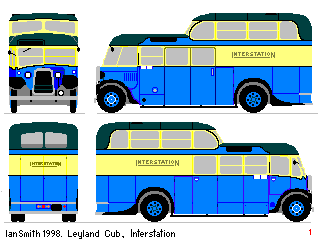 Introduced: April / October 1936.
Introduced: April / October 1936.
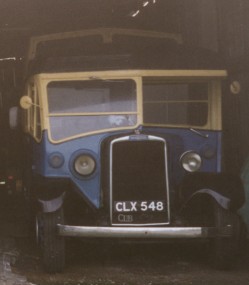
 Ian's Bus Stop
Ian's Bus Stop top of text.
top of text.